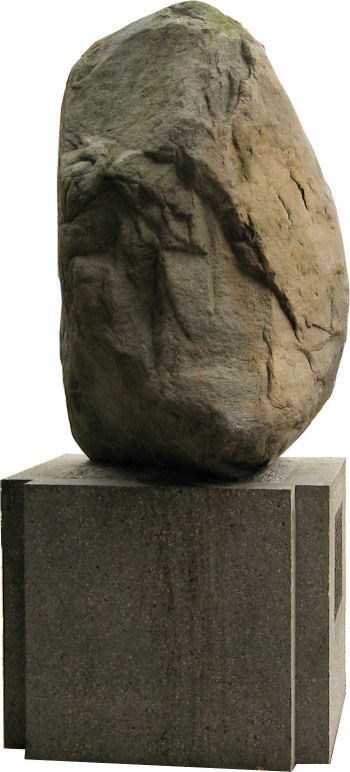| History
In the period called Pleistocene (before the glacial periods), the formation of 'Oosterhout' is formed, that is regarded as the hydro-geological base of the system of ground water levels in the 'Gelderse Vallei' and the 'Utrechtse Heuvelrug'. On this formation clay and sand is edged in the following periods.
During the penultimate glacial period, the Saalien, the ice cap reaches the Netherlands. The ice cap replaces large amounts of clay and sand after which relatively high ridges (in dutch called 'stuwwallen') and deep glacial basins are formed. The 'Gelderse Vallei' is one of these basins. Also larges boulders and rocks were transfered by the movement of the ice caps. According to measurements on the 'Amersfoortse Kei', this boulder originates from Scandinavia.
In the last glacial period, the Weichselien, the ice caps do not reach the Netherlands, but the ground is permanently frozen (permafrost).
In the relief of the 'Leusderheide' the erosion grooves from that period are still visible. During the later periods the sand-drift moves sand from the top layer along the ridges of the 'Gelderse Vallei. The long stretched rigdes are mostly formed in the East - West direction. In the Holoceen (started about 10,000 years ago) the ice caps started melting by temperature rising. The sea level raised about 100-120 meters.
The 'Leusderheide' is the place where the 'Amersfoortse Kei' was found. Continue to read the story on the 'Amersfoortse Kei'.
The story of the 'Amersfoortse Kei'.
The 'Amersfoortse Kei' is a big boulder located in the centre of Amersfoort, from this the name 'Keistad' (Bouldercity) is formed and the inhabitants are called 'Keientrekkers' (Boulderpullers).
The noble man Everard Meyster placed a bet with some of his friends that he could convince the inhabitants of Amersfoort to move a large boulder from the 'Leusderheide' into the city. It is not known how he did that, but he managed it. So on June 7, 1661 in total 400 inhabitants of Amersfoort pulled the boulder to the centre of the city (Varkensmarkt). In the local cafe 'Dolle Jonker' they all received beer and a pretzel.
To remember this occurance a commemorative coin was minted and a poem called the 'Keyklucht' was written. In 1663 Everard Meyster moved to Utrecht were he build a home with some memories to the action taken in Amersfoort. The home was called 'De krakeling' (The Pretzel). In 1674 the inhabitants of Amersfoort saw that they had been stupid to pull the boulder from the Leusderheide for no reason and were ashamed of themselves. So the boulder was buried in the centre of the city (Varkensmarkt).
Later generations were not ashamed for this action and in 1903 the boulder was excavated from the 'Varkensmarkt' and in 1954 it was placed at its current location. In the 1970's the yearly 'Keistadfeesten' were started, and from several countries different boulders were introduced into Amersfoort. These boulders are still located in the public garden near the 'Stadsring'.
How to find the 'Amersfoortse Kei'?
Parking Places can be found at 'Koestraat' N52° 09.177 E005° 23.304, and 'St. Joris Plein' N52° 09.342 E005° 23.116.
Then you can walk to the coordinates and find the 'Amersfoortse Kei'. Go to N52° 09.165 E005° 23.205.
 The earthcache The earthcache
To be able to log this cache as found you will have to perform some tasks and answer some questions:
The 'Amersfoortse Kei' is placed on a socle. On the socle to plates are attached. Answer the following questions:
-
Take a picture of yourself or your team mates and your GPSr with the 'Amersfoortse Kei' in the background.
-
What is the weight of the boulder as of 08/NOV/1990?
-
From what type of stone is the 'Amersfoortse Kei' made of?
-
Make an estimation of the height of the 'Amersfoortse Kei'
Now walk along the public garden towards the following coordinates N52° 09.189 E005° 23.492.Along the way you will pass the boulders donated by several countries. All boulders originating from different types of stone/rock. Arrived at the next coordinate, answer the following question:
To log this cache you will have to email me the answers to the questions (using my profile) and upload the picture with your log. Logs with wrong answers and/or without pictures will be deleted without notice.

|